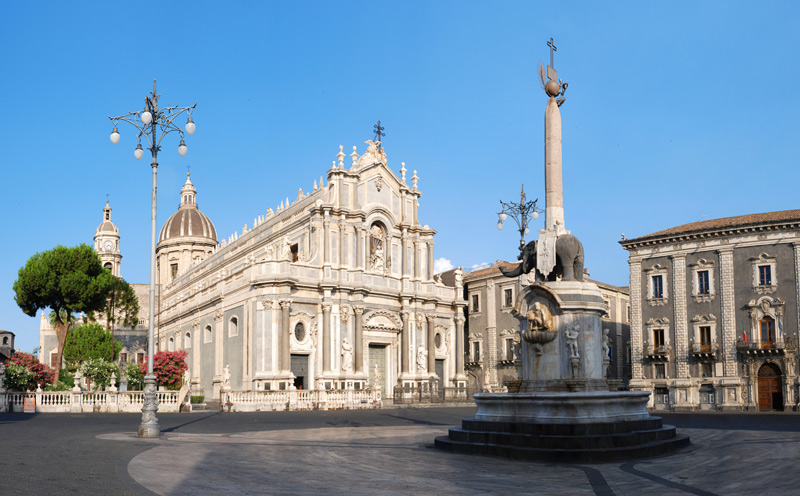
Catania is a city in Sicily, in the middle of the Ionian coast, wrapped by the Mediterranean to the east and the Etna volcano to the west. This is the second largest city of Sicily, a thriving commercial center with a well supported transportation network.
How to arrive
There are four ways to visit Catania. The first is getting a plane and landing at the Fontanarossa Airport. This airport connects several flights with the main cities of Europe. From the airport you can just take a 20 minutes trip with the bus to the Catania’s bus station.
Other ways that will help you to get to Catania are by buses from Naples and Rome, by train from Taormina, Rome, Naples, Palermo and Syracuse and last but not least and enjoyable for some, by ferry from mainland Italy.
Brief history
The main street of Catania is called Etna, named after the volcano, and any visitor can notice the volcanic stone and the black-grey themes on the buildings and the pavements. The city is best known for its volcano eruptions and the seismic history of an area, more specifically on the two particular earthquakes that have done major destructions and have cause volcanic eruptions from the Mount Etna. The two earthquakes happened in 1169 and in 1693.
Catania was founded in the 8th century BC, but it really thrived in the 14th century and the Renaissance, when it nourished future artists and was the centre of attention as a political and cultural center. Today the city of Catania is Sicily’s main source of economy and one of the largest centers of art.
The city is stated at the foot of the Mount Etna, which had both its benefits and disadvantages. The benefit was that the soil from the volcano was suitable for agriculture, but the negative is that the volcano eruptions destroyed parts of the city. Under the city we can see at the Amenano a great river.
The city of Catania has a great history because of the heritage left from civilizations that had their influence and their power on the city’s heart through the ages.
The metropolitan city of Catania is formed by the comune of Catania with about 300000 people and another 26 surrounding comuni with about 450000 people. These comuni live by a system that shares the economical and cultural life of the city.
The symbol of Catania is the Fontana dell Elefante that was created by Giovanni Battista Vaccarini in 1736 and it shows an ancient elephant topped by an Egyptian obelisk.
The city’s history as I stated is large and deep, with the mostly part being unexplored until today, because of it being buried under the layers of lava. Under these layers several hundred years ago the Greek and Roman history was covered.
A view of the history though can be seen in the Parco Archaeologico Greco-Romano di Catania Park, with displays of many of the ancient monuments. Some of the monuments include the Greek-Roman Theatre from the 2nd century, the Odeon from the 3rd century, the Amphitheatre and the Roman Aqueduct among others.
What to see
Visit the Church of the Santo Carcere or otherwise called Sant'Agata al Carcere that was built in 1760 and includes the ancient jail where Saint Agata was imprisoned and then go to Saint Francis of Assisi at the Immaculate that was built in 1329 and houses the mortal remains of Queen Eleanor of Sicily.
Then have a look at the Saint Benedict of Nursia, and why not visit at the Saint Euplius Old Church Ruins and the Church of San Gaetano alle Grotte. How about adding The Ursino Castle in your ‘to do’ list?
Visit the Crucifix of Miracles and then the Chapel of the Sacred Heart of Jesus, or go to the Ferdinandean Gate (Garibaldi Gate) (Porta Ferdinandea or Porta Garibaldi), an arch raised in 1768 to celebrate the marriage of Ferdinand I and Marie Caroline of Austria.
After so much walk don’t you want to just relax and see some of the rare plant species and other specimens that are housed in the Catania Botanical Garden?
After getting rest at the Garden, visit ‘The University of Catania’, located in the centre of the town and built in 1434 and then visit the Teatro Massimo Bellini, which is a museum dedicated to the famous opera composer Vincenzo Bellini. The museum hosts a variety of his work and other exhibitions.
Last but not least visit the Mount Etna and see the astonishing volcanic landscape with the black and white layers of lava, and end the tour with a final visit at the Acicastello, a little village with a medieval castle, build over the sea on a huge rock, offering spectacular landscape views.
After the exhausting tour try the local Sicilian food in the outdoor restaurants. Catania’s cuisine is magnificent and includes among others, dishes like pasta and the famous horse meat. Aren’t you curious to try that one? The food will certainly please all your senses.
Tips
The Catania Network consists of the Fontanarossa, the international airport, the commercial seaport (Catania seaport) and the central railway station (Catania Centrale).
The only motorways that connect the other Italian cities with Catania are the A18 Messina-Catania and the A19 Palermo-Catania motorways.
The starting point of your trip should be the Piazza Duomo, which is the main square.
Every morning you can find fresh products in the two markets:
- The large fish market in the Piazza Duomo
- The food and clothes market in Via Etnea
Do not expose jewelry or take out money in the open view, as you might jump into pickpockets and thieves.
To better explore the city rent a car or get a taxi.